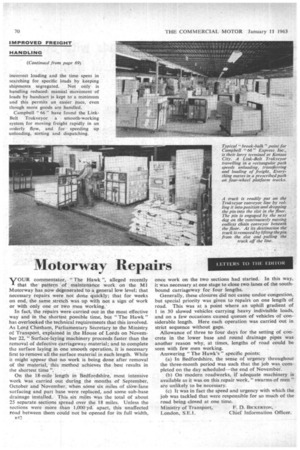Motorway Repairs
Page 72

If you've noticed an error in this article please click here to report it so we can fix it.
YOUR commentator, "The Hawk ", alleged recently -L that the pattern of maintenance work on the MI Motorway has now degenerated to a general low level; that necessary repairs were not done quickly; that for weeks on end, the Same stretch was up with not a sign of work or with only one or two men working.'
In fact, the repairs were carried out in the most effective way and in the shortest possible time, but "The Hawk" has overlooked the technical requirements that this involved. As Lord Chesham, Parliamentary Secretary to the Ministry of Transport, sexplained in the House of Lords on November 22, "Surface-laying machinery proceeds faster than the removal of defective Carriageway material; and to complete the surface laying in one smooth operation, it is necessary first to remove all the surface material in each length. While it might appear that no work is being done after removal of the material, this method achieves the best results in the shortest time ".
On the 18-mile length in Bedfordshire, most intensive work was carried out during the months of September, October and November, when some six miles of slow-lane surfacing and part base were replaced, and some sub-base drainage installed. _Thissix miles was the total of about 25 separate sections spread over the 18 miles. Unless the sections were more than 1,000 yd. apart, this unaffected road between them could not be opened for its full width, once work on the two sections had started. In this way, it was necessary at one stage to close two lanes of the southbound carriageway for four lengths.
Generally, these closures did not cause undue congestion, but special priority was given to repairs on one length of road. This was at a point where an uphill gradient of 1 in 30 slowed vehicles carrying heavy indivisible loads, and on a few occasions caused queues of vehicles of considerable length. Here each operation was carried out in strict sequence without gaps.
Allowance of three to four days for the setting of concrete in the lower base and round drainage pipes was another reason why, at times, lengths of road could be seen with few men working.
Answering "The Hawk's" specific points: (a) In Bedfordshire, the sense of urgency throughout the three-month period was such that the job was completed on the day scheduled—the end of November.
(b) On modern roadworks, if adequate machinery is available as it was on this repair work, " swarms of men" are unlikely to be necessary.
(o) It was in fact the speed and urgency with which the job was tackled that were responsible for so much of the road being closed at one time.
Ministry of Transport, F. D. BICKERTON, London, S.E.1. Chief Information Officer.
















































































































